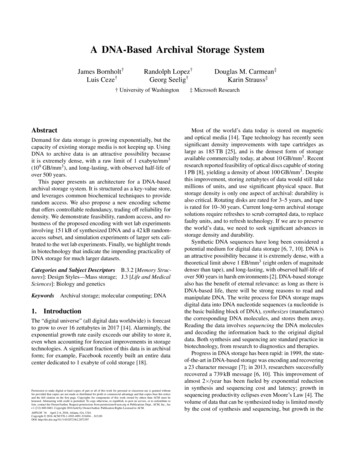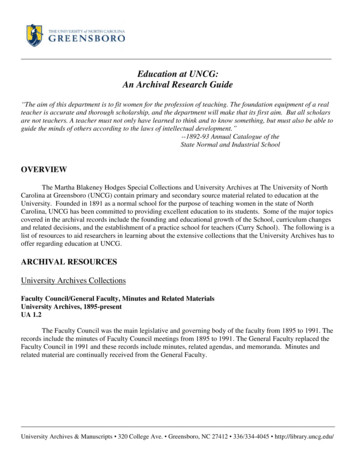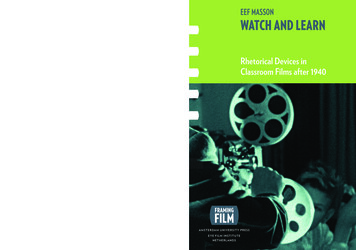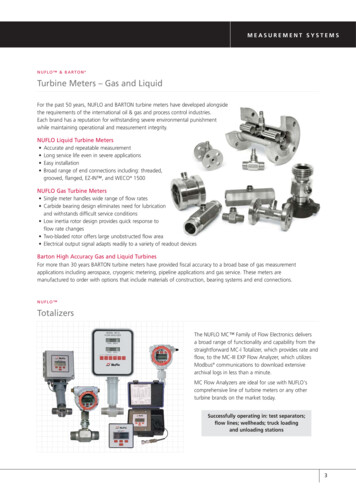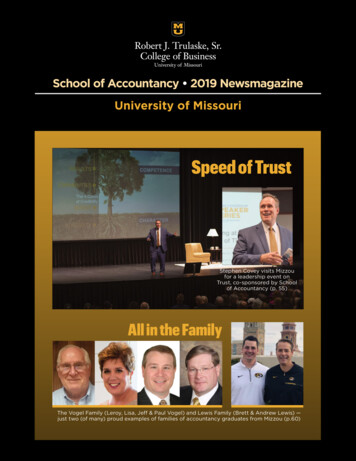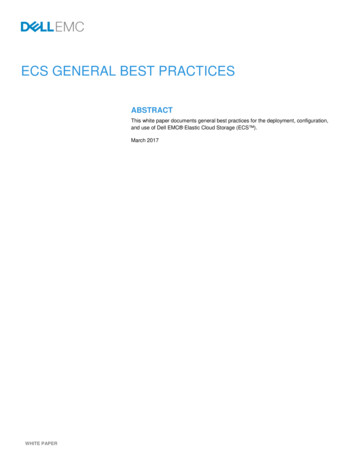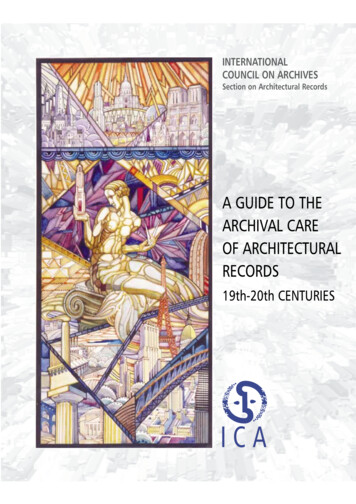
Transcription
INTERNATIONALCOUNCIL ON ARCHIVESSection on Architectural RecordsA GUIDE TO THEARCHIVAL CAREOF ARCHITECTURALRECORDS19th-20th CENTURIESICA
This work is dedicatedto the memory of Andrée Van Nieuwenhuysen.
INTERNATIONAL COUNCIL ON ARCHIVESSection on Architectural RecordsA GUIDE TO THE ARCHIVAL CAREOF ARCHITECTURAL RECORDS19th-20th centuriesICA, Paris, 2000
This work is also published in French as:Manuel de traitement des archives d’architectureContributors:Louis Cardinal, National Archives of Canada, OttawaMaygene Daniels, National Gallery of Art, Washington, D.C.Robert Desaulniers, Canadian Centre for Architecture, MontrealDavid Peyceré, Institut français d’architecture, Archives d’architecture du XXe siècle, ParisCécile Souchon, Archives nationales, service des Cartes et plans, FranceAndrée Van Nieuwenhuysen, Archives générales du Royaume, BelgiumAdvisors:Meryl Foster, Map and Picture Department, Public Record Office, Kew, United KingdomAlice Thomine, Centre des archives du monde du travail, Roubaix, FranceMariet Willinge, Nederlands Architectuurinstituut, RotterdamEditing:Maygene Daniels and David PeyceréPhotographic credits:Canadian Centre for Architecture, Montreal;Gallery Archives, National Gallery of Art, Washington, D.C.; Bert Muller, Utrecht;Denis Gagnon, National Archives of Canada, Ottawa;Koninklijke Bibliotheek, The Hague; Eric Bakker, Rotterdam;Archives nationales/Institut français d’architecture,Archives d’architecture du XXe siècle, Paris.Design: Joël Maffre International Council on Archives, 2000Published with the support of the Bureau de la recherche architecturale et urbaine,ministère de la Culture et de la communication, direction de l’Architecture et du patrimoine, France.Cover: Ernest Cormier, Cartoon for a stained glass window. Canadian Centre for Architecture, Montreal,01 Arc 61N
Table of ContentsTable of Contents9Foreword11Preface15Introduction,by Cécile Souchon21Chapter 1. Types of Architectural Records,by Andrée Van Nieuwenhuysen and David PeyceréSources of Architectural Records:Government Offices and Other OrganizationsSources of Architectural Records: Architects’ OfficesSources of Architectural Records: Contractors,Engineering Firms, EngineersTypes of Contemporary Architectural Documents: the Project FileProject DesignBid Documents and SubmissionsConstructionAcceptance of WorkLife of the BuildingMaterial Aspects of Graphic Documents: Types of RepresentationScale and DimensionsCartouche or Title BlockTraditional Media and MaterialsReproduction and PrintsModelsPhotographyNew Technologies
Table of Contents9Chapter 2. Acquisition Principles, Criteria and Methodology,by Louis CardinalPublic and Private Records and InstitutionsAcquisition Goals Defined by ICAMAcquisition PrinciplesDefining an Acquisition PolicyAcquisition Methodology49Chapter 3. Appraisal, Selection, and Disposition,by Robert DesaulniersAesthetic and Historical Criteria: Artistic ValuesDocumenting the Creative Process: Sketchesand Preliminary DrawingsDevelopment DrawingsConstruction DrawingsDocumenting the Profession of ArchitectureDocumenting the History of the Built EnvironmentDocumenting Urban and Social HistoryRestoring Architectural HeritageAdministrative CriteriaPeriods for Retaining Records in Offices and ArchivesRecords to be Disposed of Following Completion of a ProjectDocuments to be Retained Throughout the Life of a BuildingDocuments to be Disposed of After a Building is Destroyed65Chapter 4. Arrangement of Architectural Records,by Maygene DanielsPrinciples of Archival ArrangementProvenanceOriginal OrderArranging Architectural RecordsRecord GroupsRecord SeriesProblems in Arranging Architectural RecordsPartial Groups of RecordsArchitectural RenderingsRepetitive CopiesDiverse Physical FormsPhysical PreservationThe Process of ArrangementOrdering the ProcessPhysical ManagementPhysical SurveyConceptual OrganizationArranging the RecordsConclusion
Table of Contents77Chapter 5. Description of Architectural Records,by Maygene DanielsFinding Aids for Internal ControlAccession Registers and ReportsLocation RegistersFinding Aids to Assist UsersRepository and Cross-Institutional GuidesRecord Group or Fonds InventoriesSeries DescriptionFolder or Dossier-Level DescriptionsItem-Level DescriptionSurrogate or Copy ImagesSystematic Double-Level DescriptionSpecialized IndexesDelivering Finding Aids to ResearchersDeveloping an In-House Data BaseExchange of Information: Centralized Data Bases and InternetDescription Standards91Chapter 6. Conservation of Architectural Records,by Louis CardinalCauses of DeteriorationHeat and HumidityPaper, Linen and Plastic FilmPhotographic Records and BlueprintsRecords on Magnetic MediaParchment and VellumLightPollutantsInsects, Rodents and RecoveryVandalism and TheftStorage RoomsStorage CategoriesDrawer CabinetsShelvingRolls and TubesVertical CabinetsStorage of Fragile DrawingsModelsComputer RecordsFramesConservation
Table of ContentsPreservation CopyingWork Stations and the Reading RoomTransportation and PackingLoans of RecordsInsuranceConservation Bibliography119Chapter 7. Access and Dissemination: Research and Exhibitions,by David PeyceréResearchers, Readers, and VisitorsProfessional Uses for Architectural ArchivesArchitectural Archives and HistoryDissemination: Seeking a General AudienceAccess ConditionsDocument StatusStatus of the ResearcherPhysical Condition of Documents and Conditions of AccessPhysical Conditions of ConsultationConsultation of CopiesArrangement of Documents and Distribution of InventoriesOther Rights to Documentary MaterialsConclusion133Glossary of Specialized Terms for Archives of Architecture,by Maygene Daniels and David Peyceré139Further Reading,by Maygene Daniels and David Peyceré
Foreword9ForewordNearly two decades ago, the International Council on Archives (ICA)realized the importance of architectural records as chronicles ofmankind’s built environment. Recognizing the many practical problemsthese fragile, over-sized materials presented to archivists and theirinstitutions, the ICA established its Committee on Architectural Records(later known by a number of different names, including ICA/PAR,“Provisory Group on Architectural Records”), to bring increasedattention to these important documentary materials. In 1998-2000, theProvisory Group began transforming itself into a Section of the ICA.Since then, the committee has sought to increase international noticeof the importance of architectural records and to improve standards fortheir care. Members of the ICA group and the many professionalcolleagues with whom they have visited and corresponded through theyears have added their knowledge to develop a consensus of the bestinternational practices for the care of architectural records. This guideis the result of this investigation and discussion.Many people contributed to the committee’s work and discussions.Lorenzo Mannino and Jean-Pierre Babelon were early leaders, whosevision ensured the committee’s effective beginning. Later Arnaud Ramièrede Fortanier, Maygene Daniels, and Robert Desaulniers served as chairmenof the group.Individual members of the committee and other individuals too numerousto name contributed information about their own experiences andpractices essential to the development of this guide. We are gratefulfor their many ideas.Our particular thanks go to certain individuals without whom thispublication would not have been possible. Arnaud Ramière de Fortanierconceived the idea for the guide and began its evolution. The late Andréevan Nieuwenhuysen contributed her great scholarship and wisdom toits early stages.
10ForewordManuel Real provided essential information concerning descriptivepractices. Pedro Lopez Gomez generously shared his scholarlyknowledge concerning Spanish archives. Margaret Condon and MerylFoster contributed information concerning practices at the Public RecordOffice and elsewhere in the United Kingdom. Mariet Willinge has addedher knowledge of the international environment and the particularconcerns of museums of architecture and the InternationalConfederation of Architectural Museums. Alice Thomine has amplifiedinformation on modern architectural records in France. Pierre Frey hasgenerously shared his experience, especially in areas affected byelectronic technologies.As representative of the International Confederation of ArchitecturalMuseums, Jöran Lindvall (Arkitekturmuseet, Stockholm), has advocatedwith patience and wisdom the importance of sound professional practicein museums of architecture and elsewhere.Meryl Foster and Mariet Willinge read the English version of the textfor accuracy and correct international usage. Alice Thomine did thisfor the French version.The authors and committee particularly wish to thank the NationalArchives of Canada and especially Betty Kidd for support of theprofessional translation of this guide. The editors have built on thisfoundation with the goal of ensuring that the text in both French andEnglish is comprehensible to professional archivists and fully accurate.This publication has been developed with the guidance and supportof the ICA. We hope that this will be the first in a series of handbooksdedicated to providing practical information to archivists andprofessional colleagues throughout the world. Every effort has beenmade to keep its cost low so that it can be purchased and used inevery repository, no matter how small its budget. It has beenpublished in looseleaf form so that pages and sections can easily beadded or updated.With the International Congress on Archives in Seville in September 2000,the Committee on Architectural Records will officially be transformedinto a new Section on Architectural Records, open to any archivistinterested in contributing to the continuing effort to improve care andknowledge of architectural materials. Among its other activities, thesection will continue to monitor developing standards and methods.We encourage it to up-date and add to this present publication asneeded.We hope that this publication and the continuing work of the newsection will help ensure that architectural records throughout the worldare increasingly recognized as irreplaceable elements of mankind’scultural heritage, and will be cared for ever more effectively.Project Group on Architectural Records:Robert Desaulniers, ChairLouis CardinalMaygene DanielsDavid PeyceréCécile SouchonMariet Willinge
11PrefacePrefaceThis manual is the result of contributions from many archivists, boththose whose work is represented here, and the many colleagues whohave generously shared their ideas and experiences with the authors.Its goal is to provide basic information concerning the day-to-day careof architectural records. It is intended for use by archivists who maynot be familiar with the particular requirements of architectural recordsand by other colleagues who may not be uninformed concerning thebasic principles and techniques of archives administration. Itsrecommendations are valid for the care of modern architectural recordsin all institutions, whether archives, libraries, museums, or even modernarchitectural offices.Each of the chapters of the manual provides essential information ona defined aspect of the subject. All have been reviewed by the otherauthors and by members of the committee to ensure that the bestinternational practice is represented.Because this is truly a work of international cooperation, each of theauthors based his or her explanations on personal experiences andpresented them in ways familiar within his own national and linguisticcontext. Each of the authors also was encouraged to design apresentation appropriate for the subject. As a result, some of thechapters are heavily footnoted and others are not. Some refer extensivelyto published literature and others focus instead on practical experienceand accepted professional practice. We believe that this variety is thestrength of a combined effort of this nature.In any international venture, establishing definitions for specializedterminology must be a major concern. Recognizing that terminologyfor architectural archives is often used imprecisely, we have chosento prepare a glossary which defines terms broadly and givesalternatives where appropriate rather than attempting to limit usagewithin the text. Thus within the guide, computer programs for creatingarchitectural records are described both as CADD (computer-aideddesign and drafting) and CAD (computer-aided design) systems,depending on differing national usages. Similarly, the terms sketch
12Prefaceand design drawing are used to define the same concept in differentcontexts. We concluded that this variety of vocabulary enriched thepresentation of this manual and ultimately would aid the reader, whowould be likely to encounter these same terms in other contexts.The selective bibliography of additional readings on each chapter orsubject also varies considerably depending on the interests and concernsof its author. Generally, only literature that is reasonably accessiblearound the world has been included; however, in some cases, less readilyavailable works are included if these were considered by an author tobe particularly germane or significant to a particular topic. Becausethe authors of the guide worked in French and English, readings citedin the bibliography are generally limited to these languages.Each author initially wrote his text in his native language, whether Frenchor English. The texts were professionally translated due to the generosityof the National Archives of Canada. The editors then reviewed andrevised the texts extensively to reflect colloquial usage and familiararchival terminology. David Peyceré was responsible for the French textand Maygene Daniels for the English. Any errors in translation or inthe use of archival terminology are theirs.This guide presents the best elements of international practice as it hasbeen generally defined and accepted through discussions within theCommittee on Architectural records. We hope that it will help guideand serve archivists and others caring for architectural recordsthroughout the world.The authors and editors of this guide also recognize that it must berevised and up-dated regularly as architectural records and archivalpractices evolve in the coming years. The increasing importance ofcomputers in creating and maintaining architectural records andelectronic technologies for reproduction, storage, and study, inparticular, will require future study and discussion.We view this manual as a living text, and encourage others to amend,revise and add to it in the years ahead.Maygene DanielsDavid Peyceré
The Opéra-Comique in Paris, drawing by Charles Girault, 1893.Centre historique des Archives nationales, Paris, 285 AP 9/1/842.
15IntroductionIntroductionCécile SouchonThis publication is the result of international discussions concerningmanagement of architectural records, which began more than adecade ago. The manual does not claim to solve all the practicalproblems associated with the care of architectural records causedby the circumstances of their origin and their volume, size, and otherphysical characteristics. Nonetheless, by bringing togethercontributions of archivists who work with architectural records daily,it seeks to provide a better understanding of the nature of thesehistorical materials and to provide practical information for their care.Since the middle of the nineteenth century, the volume ofarchitectural records and those of related fields such as civilengineering has grown explosively. The ever-increasing complexityof building practices and the emergence of large architectural firmshas affected the quantity, nature and organization of the records.The number of architects and others involved in the building industryhas continued to grow in the contemporary world. At the same time,new copying technologies including photochemical processes suchas blueprint and diazo, photostatic machines in the mid-twentiethcentury, and more recently electronic technologies, have lead to anever-increasing volume of architectural documents.Without question, the massive physical destruction of the builtenvironment caused by this century’s wars and natural disasters hascreated an acute awareness of the fragile nature of seeminglypermanent human achievements. The quickness with which
16Introductioninformation concerning this destruction has been transmittedthroughout the world — by the black and white vision of earlyphotographs, the grey images carried by television screens, and nowthe instant data conveyed by computers — has made this awarenessof the potential for destruction almost universal.Architecture is an omnipresent companion for mankind. Thespreading urbanization on all five continents has increased theworld’s awareness of its impact on human lives.Throughout the world, buildings have unique design characteristicsand distinctive materials; nonetheless, no building is the product ofa single environment. Conceived, designed, commissioned, copied,built, paid for, traditional or new, lasting or temporary, architectureis the cumulative work of mankind.This manual is intended for use in archives throughout the world,including institutions responsible for caring for records created byprivate individuals and organizations, as well as government archives.Because of the substantial changes in the organization, physicalcharacteristics and contents of architectural records beginning in themid-nineteenth century, documents created in this modern periodare given primary attention here.The history of building styles, urban development, and civilengineering projects through the centuries has been amply studied.These subjects are documented by maps and plans, engravings andpaintings or models and other visual materials, which may depictbuildings or urban settings which have been destroyed orsubstantially altered over time. These documents may be valuableas individual, often beautiful objects, treasured by collectors for theirunique interest, rather than because of the information they containas part of a larger archival group. Such documents are often boughtand sold, and, once out of the hands of private collectors, may bepreserved as individual items in museums, libraries, or sometimesarchival collections. They typically are managed in accordance withlibrary or museum methodology rather than following archivalpractices.In contrast, this guide emphasizes the care of groups of architecturalrecords created in the course of the modern practice of architecture.These records provide evidence concerning the relationships ofarchitects, contractors, and clients of every social level, and revealthe new reality created by the accelerating tempo of modern times.Recognizing that in modern times architects have been transformedfrom solitary artists or masters into participants in the corporate andcollective process of modern construction, this guide seeks to focusattention on bodies of records created by architects within thecontext of their firms and the business of architecture. Architects,the aristocratic heirs of a longstanding tradition, have respondedto the desires of a new clientele. The records they have created reflectthis new situation.Although records of modern architectural offices as we know themnow seem to follow established patterns, it is unrealistic to believethat they will remain unchanged in the future. The various media
Introductionin which architectural records are created closely mirror technologicaldevelopments in the field of architecture as well as evolution in theway that buildings are planned, financed, and constructed.The world wars and the long years spent rebuilding destroyed citiesfrom ruins, especially in Europe, the efforts to restore a familiarframework to life, and frenetic technical competition all have brokenthe continuity of the intellectual traditions of architecture. Greaterindustrial standardization in building materials has continued tonourish the old debate between quantitative and qualitative valuesand between artistic creation and industrial accomplishment. At thesame time that these forces have affected architectural practice, theyalso have had a profound influence on the character of architecturalrecords, which themselves have become more uniform and lesspersonalized, a trend that is likely to continue.This manual largely concerns the records maintained by architectsand their offices as evidence of their work, in contrast to the recordsof clients or government offices, which document other aspects ofthe building process.In the modern practice of architecture, the time between design andconstruction of a building and debate and discussion concerning itsqualities continues to shorten. Modern architectural records aretherefore of ever greater interest to researchers studying shifts inideas and cultural trends of the recent past. Just as researchersstudying scientific breakthroughs seek to come as close as possibleto the source of the concept, so researchers studying the builtenvironment seek modern architectural records as a contemporarymirror to the still mysterious and fascinating act of creation.Archival collections or fonds which now are entering archivalinstitutions sometimes come from firms involved with technicaldesign and construction but often are from architects or architecturalfirms. The architects whose work is represented in archives may havehad brilliant careers or they may be less well known. Their impactmay have been as teachers of generations of students, or as masterswho trained disciples in their ateliers. In every case, they will havetried to respond to requirements of their times and will have left theirmark on the field of architecture, on the cultural life of their era, onthe visible environment, and on the lifestyles of their contemporariesand of successive generations.Whether architectural records were created by well-known architectsor came from the drafting tables of the less-known, care of thesedocuments will present similar problems for archivists. The problemsbecome especially discouraging if the knowledge and experience ofother archivists responsible for similar records is not available.– After the architect’s legal liability has ended, assuming thatarchitectural documents have been well cared for by their creatorsand owners, their long-term physical conservation is directlyrelated to their quantity, their size and their overall volume; thegraphic media or materials of which they were crated, and theirresistance to handling, environmental conditions, reproduction,folding and successive use.17
18Introduction– After the architect’s efforts to establish his local, national orinternational reputation have ended, the scheduling, selection,and potential destruction of architectural documents depend onresources and interests of archival repositories and on their abilityto receive and maintain the documents as evidence of the workand thought of the architect or of techniques and types ofconstruction, or indeed the art of the time.– After the end of the architect’s era, furthermore, there is noguarantee that architectural records, regardless of their value,will even be legible, regardless of whether they are on paper,have been annotated or reworked by hand, or are highlytechnical. The life-span of digital documents especially isunknown and may be dependent on specific technologies, whichmay not exist in the future. Archivists do not conserve recordsfor the sake of keeping them. They keep them to serve varioususers: architects, architecture students, sociologists, historiansof art and thought, exhibition visitors and others who may learnand benefit from the materials.These observations have led the authors of this manual and the otherswith whom they have worked through the years to develop apublication which will serve as a reference for all archivists who areseeking to improve the conservation of architectural records inresponse to the concerns of researchers. From this point of view,the interests of all institutions responsible for architectural recordsare the same. There are no blind walls in the house of knowledge.This manual is thus intended as a guide to principles and essentialpractices for the care of modern architectural records, a task whichfew archival custodians will be able to avoid in the coming years.
Preliminary Sketch.I. M. Pei, preliminary sketch for the East Building of the National Gallery of Art, Washington, D.C., 1969.Gallery Archives, National Gallery of Art, Washington, D.C.
21Types of Architectural RecordsChapter 1Types of Architectural RecordsAndrée Van Nieuwenhuysen, David PeyceréArchitectural records as they are considered here include not only recordsof architectural offices, which will be described in detail below, but alsoarchitectural documents preserved in the files of clients andadministrative offices.Sources of Architectural Records:Government Offices and Other OrganizationsA variety of government offices and other public or private institutionshave architectural functions or hold architectural records.1 Somenational, regional, or local government bodies, including departmentsof public works, urban planning offices, and bureaus responsible forclassifying and maintaining historical buildings and monuments aredirectly responsible for architectural projects. Large municipalities oftenhave building construction departments established to design andsupervise building construction.Professional associations of architects also may hold architecturaldocuments or influence the creation or preservation of these materials.The Royal Institute of British Architects (RIBA), for example, collectsarchitectural records,2 as does the American Institute of Architects (AIA),which has published a pamphlet giving advice to architects on how topreserve their records.3 In Spain, regional associations of architects(Colegios de arquitectos) review all architectural projects submitted intheir areas of jurisdiction. On the other hand, it is worth noting thatin France, the professional association of architects is not involved eitherin architectural decisions or in preserving the history of architecture.Architectural documents preserved in public depositories also may comefrom other sources. Examples include:Andrée Van Nieuwenhuysenprepared an unfinished draftof this chapter before her deathin January 1995.The text was revised and completedby David Peyceré.1 See presentation given by Pedro LópezGómez, Normas descriptivas paradocumentos arquitectónicos: lapráctica en España, at the meeting ofthe International Council on ArchivesWorking Group on ArchitecturalRecords, Washington, D.C., September1992.2 A. Mace, The Royal Institute of BritishArchitects. A Guide to its Archive andHistory, London, New York, 1986. TheInstitute has some 400,000 plans anddrawings dating from the fifteenthcentury to the present.3 Nancy C. Schrock, Architectural recordsmanagement, Washington, D.C.: TheAmerican Institute of ArchitectsFoundation, 1985.
22Types of Architectural Records– building records of palaces, castles and royal estates (accounts andplans), councils of government, provincial governments;– archives of abbeys, ecclesiastical institutions and parish councils;– archives of prominent families, containing plans or other documentsrelating to buildings, castles, gardens, farms, houses, factories,churches, chapels, or subdivisions;– notaries’ records, which sometimes include building plans appendedto deeds4 (Although lengthy5 research may be needed to locate suchplans, the detailed information found in the deeds sheds light on realestate transactions (subdivisions of land, property lines, construction)in a variety of ways); and– legal records, which include site surveys or reports by architects,surveyors and engineers. (The archives of the court of first instancein Brussels, for example, contain a series of site surveys made in thenineteenth century in connection with public utilities. These reportsalways contain an architectural description and often include plans.They are particularly significant for study of the character of olderparts of cities before the major construction projects of thenineteenth century.)Sources of Architectural Records:Architects’ OfficesFor many years, architecture in Europe was a liberal profession practicedby individuals. Architects as we know them, that is independentprofessionals practicing in cities with private clients, began to appearduring the eighteenth century, with their numbers increasing during thefirst half of the nineteenth century.Architects today generally work in teams for corporate offices orpartnerships where they may be salaried or may receive a share of theprofits. In modern architectural offices, the work is often distributedamong specialists, including urban planners, architects, draftsmen,engineers and others, who each is responsible for an aspect of the buildingthat is being planned.4 The relevance of notaries’ records fromthe nineteenth century to the study ofarchitecture has been highlighted byWerner Szambien, “Les archives del’architecture au minutier central desnotaires,” Archives et histoire del’architecture, 1990, pp. 53-56.5 Ibid.6 Alan K. Lathrop, “The Provenance andPreservation of Architectural Records,”The American Archivist, vol. 43, no. 3,summer 1980.7 See the texts published in Architecture,une anthologie (under the direction ofJean-Pierre Épron), vol. II and III, Parisand Liège, 1992 and 1993; also theessays collected in Les architectes,métamorphose d’une professionlibérale (under the direction ofRaymonde Moulin), Paris, 1970.In the United States, the trend toward corporate architectural practiceemerged with the construction of skyscrapers and large commercialbuildings toward the end of the nineteenth century.6 In Europe,
the Committee on Architectural Records will officially be transformed into a new Section on Architectural Records, open to any archivist interested in contributing to the continuing effort to improve care and knowledge of architectural materials. Among its other activities, the section w

